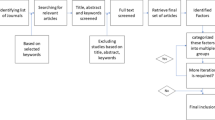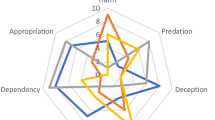Abstract
The emergence of cross-border e-commerce has brought new opportunities to traditional enterprises. This paper discusses the partner selection of cross-border e-commerce companies in the B2B mode. It constructs a theoretical model of partner selection of cross-border e-commerce enterprises based on literature review. Through the mathematical analysis of an asymmetric evolutionary game model, it is considered that the model has an evolutionarily stable strategy. Based on it, a multi-agent model is constructed. The results of the simulation reveal the mediation role of trust between corporate reputation and enterprise cooperation. Simultaneously, it verified the moderation effect of information sharing between the trust and cooperation of cross-border e-commerce companies. It also provides explanations for the inconsistency in the relationship between trust and cooperative behavior. From both mathematical and data perspectives, this paper attempts to test the theoretical model proposed, which enriches the methodology to test the theory.







Similar content being viewed by others
References
Cui, Y., Mou, J., Cohen, J., & Liu, Y. (2019). Understanding information system success model and valence framework in sellers’ acceptance of cross-border e-commerce: A sequential multi-method approach. Electronic Commerce Research. https://doi.org/10.1007/s10660-019-09331-0.
Lin, F.-R., Huang, S.-H., & Lin, S.-C. (2002). Effects of information sharing on supply chain performance in electronic commerce. IEEE Transactions on Engineering Management,49(3), 258–268.
Terzi, N. (2011). The impact of e-commerce on international trade and employment. Procedia - Social and Behavioral Sciences,24, 745–753.
Song, B., Yan, W., & Zhang, T. J. (2019). Cross-border e-commerce commodity risk assessment using text mining and fuzzy rule-based reasoning. Advanced Engineering Informatics,40, 69–80.
Gomez-Herrera, E., Martens, B., & Turlea, G. (2014). The drivers and impediments for cross-border e-commerce in the EU. Information Economics and Policy,28, 83–96.
Cavusgil, S. T., Deligonul, S., & Zhang, C. (2004). Curbing foreign distributor opportunism: An examination of trust, contracts, and the legal environment in international channel relationships. Journal of International Marketing,12(2), 7–27.
Jap, S. D. (2007). The impact of online reverse auction design on buyer–supplier relationships. Journal of Marketing,71(1), 146–159.
Christopher, M., & Towill, D. R. (2000). Supply chain migration from lean and functional to agile and customised. Supply Chain Management,5(4), 206–213.
Fischer, M., Jähn, H., & Teich, T. (2004). Optimizing the selection of partners in production networks. Robotics and Computer-Integrated Manufacturing,20(6), 593–601.
Fama, E. (1980). Agency problems and the theory of the firm. Journal of Political Economy,88(2), 288–307.
Fombrun, C. J., & Riel, C. B. M. V. (1997). The reputational landscape. Corporate Reputation Review,1(1), 5–13.
Ngowi, A. B. (2007). The role of trustworthiness in the formation and governance of construction alliances. Building and Environment,42(4), 1828–1835.
Chang, L., Ouzrout, Y., Nongaillard, A., Bouras, A., & Jiliu, Z. (2014). Multi-criteria decision making based on trust and reputation in supply chain. International Journal of Production Economics,147, 362–372.
Axjonow, A., Ernstberger, J., & Pott, C. (2018). The impact of corporate social responsibility disclosure on corporate reputation: A non-professional stakeholder perspective. Journal of Business Ethics,151(3), 1–22.
Elving, W. J. L. (2013). Scepticism and corporate social responsibility communications: The influence of fit and reputation. Journal of Marketing Communications,19(4), 277–292.
Davidson, S., Filippi, P. D., & Potts, J. (2018). Blockchains and the economic institutions of capitalism. Journal of Institutional Economics,14(4), 1–20.
Zucker, L. G., Darby, M. R., Brewer, M. B., & Peng, Y. (1995). Collaboration structure and information dilemmas in biotechnology: Organizational boundaries as trust production. National Bureau of Economic Research.. https://doi.org/10.3386/w5199.
Kramer, R. M., & Tyler, T. R. (1995). Trust in organizations: Frontiers of theory and research. California Thousand Oaks: Sage Publications.
Uzzi, B. (1997). Social structure and competition in interfirm networks: The paradox of embeddedness. Administrative Science Quarterly,42(1), 35–67.
Barden, J. Q., & Mitchell, W. (2007). Disentangling the influences of leaders’ relational embeddedness on interorganizational exchange. Academy of Management Journal,50(6), 1440–1461.
Gulati, R., & Singh, H. (1998). The architecture of cooperation: Managing coordination costs and appropriation concerns in strategic alliances. Administrative Science Quarterly,43(4), 781–814.
Chrupala-Pniak, M., Grabowski, D., & Sulimowska-Formowicz, M. (2016). The value of trust in inter-organizational relations 1. Economics and Business Review,2(2), 127.
Vangen, S., & Huxham, C. (2003). Nurturing collaborative relations: Building trust in interorganizational collaboration. The Journal of Applied Behavioral Science,39(1), 5–31.
Zaheer, A., Mcevily, B., & Perrone, V. (1998). Does trust matter? Exploring the effects of interorganizational and interpersonal trust on performance. Organization Science,9(2), 141–159.
Chu, W. H. J., & Lee, C. C. (2006). Strategic information sharing in a supply chain. European Journal of Operational Research,174(3), 1567–1579.
Wuyts, S., & Geyskens, I. (2005). The formation of buyer–supplier relationships: Detailed contract drafting and close partner selection. Journal of Marketing,69(4), 103–117.
Ren, Z. J., Cohen, M. A., Ho, T. H., & Terwiesch, C. (2010). Information sharing in a long-term supply chain relationship: The role of customer review strategy. Operations Research,58(1), 81–93.
Sanders, N. R., & Premus, R. (2005). Modeling the relationship between firm IT capability, collaboration, and performance. Journal of Business Logistics,26(1), 1–23.
Chiesa, G. (2005). Information sharing and optimum financing mode. The Manchester School,73(1), 50–74.
Jain, V., Kumar, S., Soni, U., & Chandra, C. (2017). Supply chain resilience: Model development and empirical analysis. International Journal of Production Research,55(22), 6779–6800.
Zineldin, M. A. (1998). Towards an ecological collaborative relationship management A. European Journal of Marketing,32(11–12), 1138–1164.
Herzig, A., Lorini, E., Hübner, J. F., & Vercouter, L. (2010). A logic of trust and reputation. Logic Journal of the IGPL,18(1), 214–244.
Heugens, P. P. M. A. R. (2004). Fame & fortune: How successful companies build winning reputations. Corporate Reputation Review,6(4), 390–395.
Castro, G. M. D., López, J. E. N., & Sáez, P. L. (2006). Business and social reputation: Exploring the concept and main dimensions of corporate reputation. Journal of Business Ethics,63(4), 361–370.
Cable, D. M., & Turban, D. B. (2003). The value of organizational reputation in the recruitment context: A brand-equity perspective. Journal of Applied Social Psychology,33(11), 2244–2266.
Jr, R. L. H. (2008). The impact of firm reputation and failure severity on customers’ responses to service failures. Journal of Services Marketing,22(5), 385–398.
Fu, F., Hauert, C., Nowak, M. A., & Wang, L. (2008). Reputation-based partner choice promotes cooperation in social networks. Physical Review E,78(2), 026177.
Fombrun, C. J. (1998). Indices of corporate reputation: An analysis of media rankings and social monitors’ ratings. Corporate reputation review,1(4), 327–340.
Tomz, M. (2012). Reputation and international cooperation: Sovereign debt across three centuries. Princeton, NJ: Princeton University Press.
Suzuki, S., & Akiyama, E. (2005). Reputation and the evolution of cooperation in sizable groups. Proceedings of the Royal Society B Biological Sciences,272(1570), 1373–1377.
Gong, B., & Yang, C. L. (2010). Reputation and cooperation: An experiment on prisoner’s dilemma with second-order information. Rochester, NY: Social Science Electronic Publishing.
Koch, K. (2017). The spatiality of trust in EU external cross-border cooperation. European Planning Studies,26(3), 1–20.
Daniel, B., & Van Lange, P. A. M. (2013). Trust, conflict, and cooperation: A meta-analysis. Psychological Bulletin,139(5), 1090–1112.
Mcknight, D. H., Lankton, N. K., Nicolaou, A., & Price, J. (2017). Distinguishing the effects of B2B information quality, system quality, and service outcome quality on trust and distrust. Journal of Strategic Information Systems,26(2), 118–141.
Wallo, A., & Kock, H. (2018). HR outsourcing in small and medium-sized enterprises. Personnel Review,47(5), 1003–1018.
Madeira, M. A. (2016). New trade, new politics: Intra-industry trade and domestic political coalitions. Review of International Political Economy,23(4), 677–711.
Cheung, M. S., Myers, M. B., & Mentzer, J. T. (2010). Does relationship learning lead to relationship value? A cross-national supply chain investigation. Journal of Operations Management,28(6), 472–487.
Hosmer, L. T. (1995). Trust: The connecting link between organizational theory and philosophical ethics. Academy of Management Review,20(2), 379–403.
He, W., & Chen, S. H. (2014). Game analysis of determinants of stability of semiconductor modular production networks. Sustainability,6(8), 4772–4794.
Friedman, D. (1991). Evolutionary games in economics. Econometrica,59(3), 637–666.
China Cross-border E-Commerce Market Data Monitoring Report, http://www.100ec.cn/zt/2018kjsj/. Retrieved on July 5, 2019.
Zhu, W., Mou, J., & Benyoucef, M. (2019). Exploring purchase intention in cross-border e-commerce: A three stage model. Journal of Retailing and Consumer Services. https://doi.org/10.1016/j.jretconser.2019.07.004.
Kim, D. J., Song, Y. I., Braynov, S. B., & Rao, H. R. (2005). A multidimensional trust formation model in B-to-C e-commerce: A conceptual framework and content analyses of academia/practitioner perspectives. Decision Support Systems,40(2), 143–165.
He, W. (2017). Coevolution of interorganizational psychological contract and interorganizational relationship: A case study of manufacturing company in China. Discrete Dynamics in Nature and Society. https://doi.org/10.1155/2017/9370969.
Williamson, O. E. (2007). The economic institutions of capitalism. Firms, markets, relational contracting. In C. Boersch & R. Elschen (Eds.), Das Summa Summarum des Management. Wiesbaden: Gabler.
Xiao, L., & Mou, J. (2019). Social media fatigue—Technological antecedents and the moderating roles of personality traits: The case of WeChat. Computers in Human Behavior. https://doi.org/10.1016/j.chb.2019.08.001.
Chen, S. H. (2016). The influencing factors of enterprise sustainable innovation: An empirical study. Sustainability,8(5), 425.
Acknowledgements
This work is supported by the NSFC (71462009); Science and Technology Project Founded by the Education Department of Jiangxi Province (GJJ190292); Jiangxi Province Teaching Reform Research Project under Grants No. (JXJG-18-4-29); Jiangxi Natural Science Fund (20192BAB207010).
Author information
Authors and Affiliations
Corresponding author
Ethics declarations
Conflict of interest
The author declares no conflict of interest.
Additional information
Publisher's Note
Springer Nature remains neutral with regard to jurisdictional claims in published maps and institutional affiliations.
Rights and permissions
About this article
Cite this article
Chen, S., He, Q. & Xiao, H. A study on cross-border e-commerce partner selection in B2B mode. Electron Commer Res 22, 1–21 (2022). https://doi.org/10.1007/s10660-020-09403-6
Published:
Issue Date:
DOI: https://doi.org/10.1007/s10660-020-09403-6




